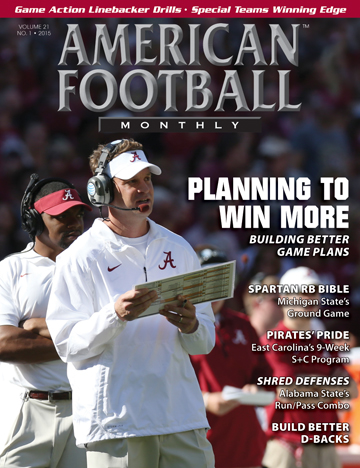Article CategoriesAFM Magazine
|
Safety First: Be Safe in Your Weight Room (Part II)by: AFM Editorial Staff© More from this issue What are the most important safety procedures in the weight room? AFM posed this question to Jim Kielbaso, the Director of Total Performance Training Centers (MI), Jim McGuire, the Assistant Director of Strength and Conditioning at Merrimack College, and Dan Leary, an assistant coach and the strength and conditioning coach at Seaside High School (OR). In part two of this conversation, the three coaches offer their guidance on spotting and proper procedures for an injury in the weight room. While I used to spot the squat all the time, I now believe that it’s safer to teach good technique, select appropriate weights, prescribe correct sets and reps, and use the safety catches when necessary. I will still provide a spot when necessary, but it’s usually best to simply stop the set when you know a spot is going to be necessary. I never spot the deadlift or trap bar squat. If the athlete can’t lift the weight with good form, it should be stopped and coached. Trying to assist with these lifts can cause more harm than good. We will typically spot accessory lifts such as chest-supported rows, chins, pulldowns, etc., to help athletes perform reps. These exercises are relatively easy to spot and it can be helpful to provide assistance at the end of a set. We also do not spot squats, front or back. We use our crash bars and make sure they are set at the appropriate height for each athletes. As with Olympic movements, we teach our athletes how to safely “miss” squat reps. Every single set of the bench press in our room is spotted as soon as a plate (any weight) is added to the bar. Our bench press spotting procedure is as follows: We also like to spot during kettlebell TGUs. Spotting does more than just assist the athlete lifting. It also, hopefully, shows the spotters good technique. By keeping two spotters at each bench or squat rack we develop a flow of work with our athletes. All three rotate lifting which is much more efficient. You first need to make sure the athlete is safe and no additional dangers are present. Next, quickly assess the injury to determine what needs to happen next. If it’s a bad injury, have someone call EMS immediately and get an athletic trainer if one is available. Always stay with the athlete to provide assistance. If blood is present, administer first aid and clean up the blood following standard blood-born pathogens procedures, i.e. latex gloves, cleaning solutions, etc. In the case of less-severe injuries, such as a pulled muscle, stop the exercise immediately and enlist the help of an athletic trainer whenever possible. You should always have an incident report to document injuries and how they were handled. Unfortunately, I still see training methods used in high school weight rooms that are dangerous to the long-term health of young athletes. While squatting, cleaning or deadlifting heavy weight with poor form may not cause an immediate injury all the time, the long-term health of an athlete’s spine is being put at risk. Constantly using weights that are too heavy or rewarding athletes for lifting a weight with poor form is a set up for long-term problems that can easily be avoided simply by focusing on the health and safety of your athletes. Twenty years from now, I would hate to have athletes paying the price for poor training methods when we have better options at our disposal. So, while I believe that weight room safety is vital to avoid immediate injuries, we should also consider the long-term consequences of what we’re doing. |
|
| HOME |
MAGAZINE |
SUBSCRIBE | ONLINE COLUMNISTS | COACHING VIDEOS |
Copyright 2025, AmericanFootballMonthly.com
All Rights Reserved




